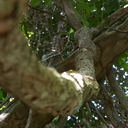In the tropics, forests are home to more than just trees – a large fraction of the total biomass comes from lianas and hemiepiphytes. Lianas are woody vines that originate from the ground, while hemiepiphytes are plants that begin growing on another plant but eventually grow roots that reach the ground. Both types of plants reach sizes that are surprising if you have only been in temperate areas.
In the photo below, Amanda is sitting on a liana with a diameter of nearly nine centimeters. Despite this large size, the stem is very flexible because nearly all its carbon is invested in water-transporting tissues rather than dense wood. Lianas are parasites that use other plants for structural support (some plants may appear to begin growth as trees but will quickly reach a prone position and then twine up the nearest real tree). Here this liana forms a catenary curve, draped between high points in two parts of the canopy.
This is the same liana, looking up into the branches of a nearby tree. Lianas can be very difficult to identify, because they typically have leaves only at the very top of the canopy where sunlight is available. Also, lianas often branch repeatedly, forming long arcs and loops that dive up and down through the forest, sometimes passing underground, only to reappear elsewhere. Tracing one of these plants is like working one’s way through a maze.
Hemiepiphytes are also quite common. Here is a Philodendron that rises sixty feet into the sky and that has nearly killed its host tree. The long structures you see me holding are aerial roots that appear from different points on the plant’s stems. Even if the host tree were to die and fall, this Philodendron would not die, because its growth extends through a large patch of swampy forest and up several nearby trees too. It is a plant which appears sinister, but which also demands respect.
These climbing and twining plants are increasing in abundance in forests worldwide. No one is quite sure why yet, through several ideas exist (Schnitzer et al. 2011). Certainly these large-scale changes will have dramatic effects on forest diversity and performance in the coming decades.




Comments
One response to “Climbers and twiners”
here the way pics are presented is good but concept of clearity still lacks
hi I am a student of class 11nth want to be a botany professor
thanks for helping